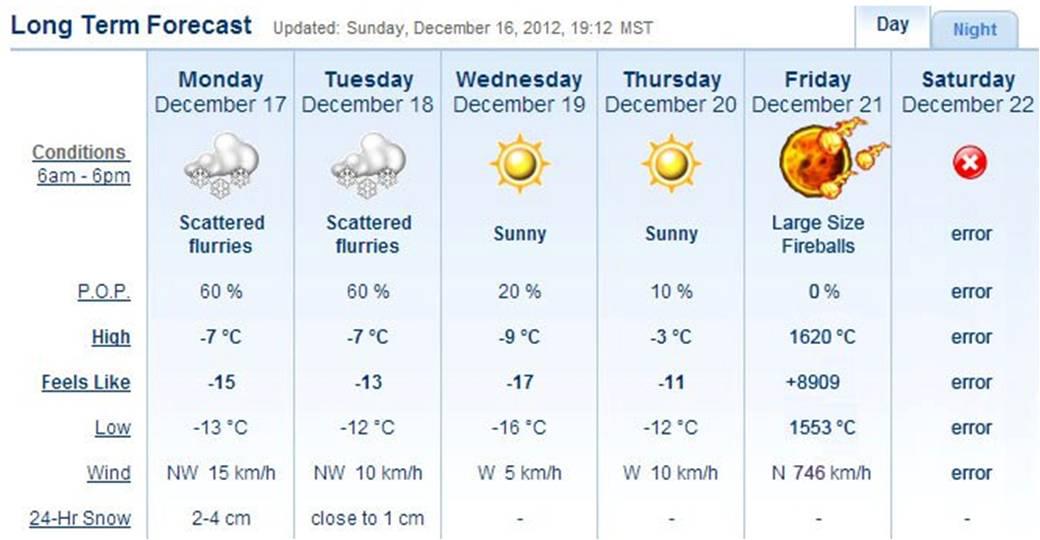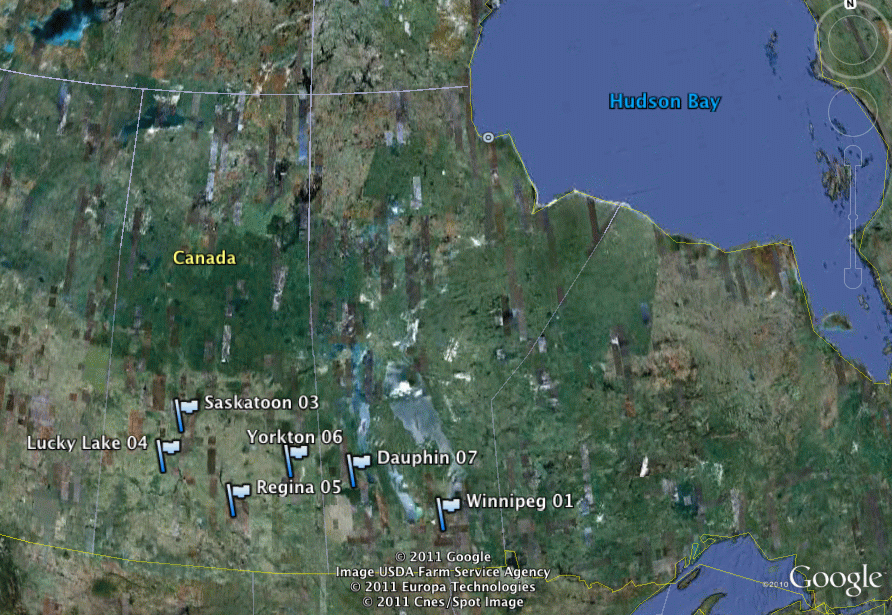
Past driving software: The camera fireball2 (originally on the roof of the U of S Physics Building) used the Sandia sentinel software written by Joe Chavez with a sentinel box. Martin Beech's camera, fireball5, is off-network and records to VCR tape. Cameras fireball1, 3, 6 and 7 originally used Rob Weryk's Asgard software with a video capture card. All (except fireball5) recorded only when a bright transient event triggers them at night.
The following table and map lists the past location of the cameras. Only fireball4 remains in service on the Sky Sentinel Network. Others may be added according to the work of the listed operators.
| Camera | Past Location | Longitude | Latitude | Elevation | Operator |
| fireball1 | Winnipeg, Manitoba - decommissioned, hardware with Rick Huziak - Larry maintains a newer camera of his own. | 97.080 W | 49.901 N | 230 m | Larry Gundrum |
| fireball3 | Saskatoon, roof of Physics Building - decommissioned, hardware with Rick Huziak. May move to another Saskatoon location on the Sky Sentinel Network. | 106.634 W | 52.132 N | 569 m | Gordon Sarty |
| fireball4 | Lucky Lake, Saskatchewan - now node 86 on the Sky Sentinel Network. | 107.264 W | 51.154 N | 724 m | Tenho Tuomi |
| fireball5 | Regina, Saskatchewan - VCR camera - status unknown. | 104.417 W | 50.417 N | 575 m | Martin Beech |
| fireball6 | Yorkton, Saskatchewan - to possibly remain in same location on the Sky Sentinel Network. | 102.521 W | 51.209 N | 519 m | Jim Huziak |
| fireball7 | Dauphin, Manitoba - permanently offline - Ron has maintained another camera of his own. | 100.192 W | 50.993 N | 420 m | Ron Lupack |

Here is a small diary of interesting events caught by the cameras:
Collaboration with International Space Station - April 21-22, 2012
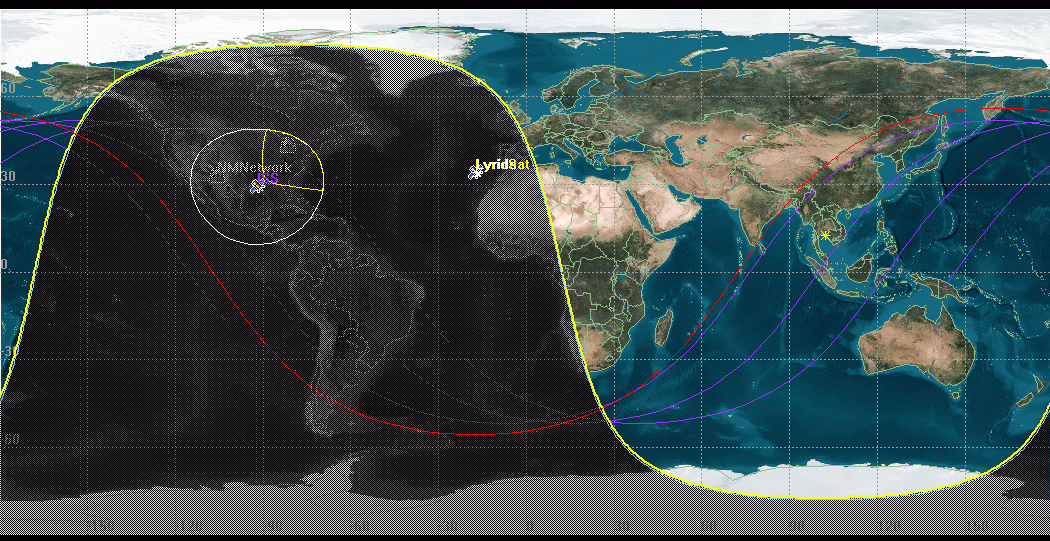
Bill Cooke of NASA MSFC wrote: "Even though the April Lyrids are not noted for spectacular rates, the combination of a New Moon near the shower peak and a very favorable viewing geometry from the International Space Station (ISS) presents a unique opportunity to simultaneously image shower meteors from both the ground and from space. Through the appropriate channels, the NASA Meteoroid Environments Office (MEO) has communicated the Lyrid viewing circumstances to astronaut Don Pettit on the ISS, who will attempt to image Lyrid meteors with onboard equipment near the shower peak. Even though this equipment was designed for tasks other than meteor observing, Don is a skilled amateur astronomer, and we have every confidence that he will maximize the chances of capturing a Lyrid from 400 km above Earth's surface. Feedback from the ISS is not immediate, but it is expected that we will receive in fairly short order the times that a meteor was observed from the station, to be followed in due course by the image/video of the event(s).
"The MEO is requesting that operators of meteor cameras, particularly all sky cameras, turn on their systems during the night of the Lyrid peak (April 21-22) to maximize the chances of simultaneous ground/ISS observations. We are asking that the operators transmit the times of the meteors observed by their cameras near the Lyrid peak so that we can correlate with the times of any events observed by ISS. Please send ONLY the times and approximate location of the camera; no video or stills are needed until after the correlations are made. We will send an email to the operator(s) requesting this additional data in the event of a match."
Meteors were detected by cameras of the Saskatchewan Fireball Camera Network the night of April 21-22 and reported to Bill Cooke, but none were coincidental with any meteors recorded by Don Pettit. Here is the list of detections from the Saskatchewan Fireball Camera Network for April 21-22:
Times are April 22, 2012 UT
| UT | Location | ||
|---|---|---|---|
| 08:25:33 | 97.080W | 49.901N | Winnipeg |
| 08:27:53 | 106.634W | 52.132N | Saskatoon |
| 08:27:53 | 107.264W | 51.154N | Lucky Lake |
| 08:28:12 | 107.264W | 51.154N | Lucky Lake |
| 08:29:21 | 107.264W | 51.154N | Lucky Lake |
| 10:08:44 | 100.192W | 50.993N | Dauphin |
| 10:10:01 | 106.634W | 52.132N | Saskatoon* |
| 10:10:01 | 107.264W | 51.154N | Lucky Lake* |
| 10:42:37 | 107.264W | 51.154N | Lucky Lake |
| 10:45:52 | 107.264W | 51.154N | Lucky Lake |
| 10:45:57 | 106.634W | 52.132N | Saskatoon |
| *coincidence detection with computed orbit - a Lyrid | |||
Fireball of February 21, 2012
From the Lucky Lake camera, fireball4 (click on image for video if your browser can play avi files):
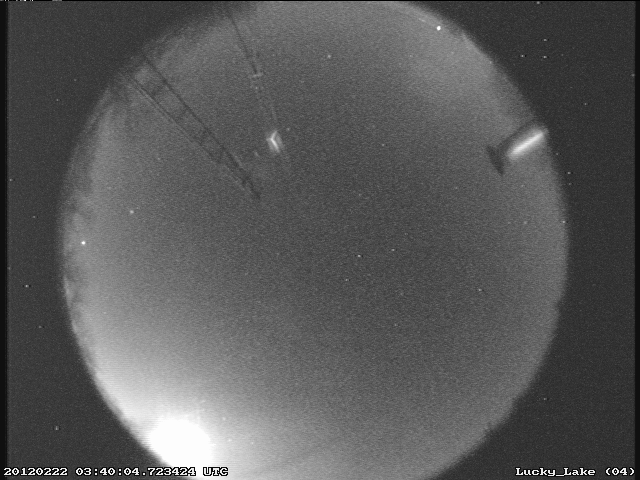
The event from Calgary: u-tube video. From Corman Park, a security video.
Buzzard Coulee Fireball - November 21, 2008
A bright fireball on November 21, 2008 caught lots of media attention, see on-line article from Astronomy magazine. Meteorites were found, see another article with some photos by Rick Huziak. Below are 3 frames from the fireball4 (then in Saskatoon) video and an image of a meteorite I found, with Garry Stone, when I joined Alan Hildebrand's search team on December 4. More pictures from that search can be found by clicking on the meteorite image below. Another search in the spring of 2009 was organized. I have been out looking a second time, for pictures of that trip, look here. See Bob Johnson's blog on his Buzzard Coulee experience (beware - the site is a busy bandwith hog). And I have been out looking a third time and a fourth time to be a BBC extra.
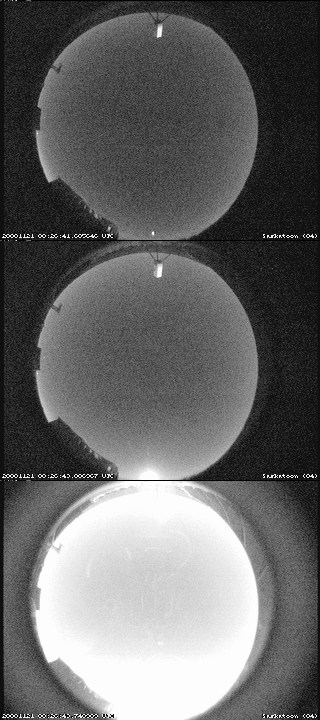
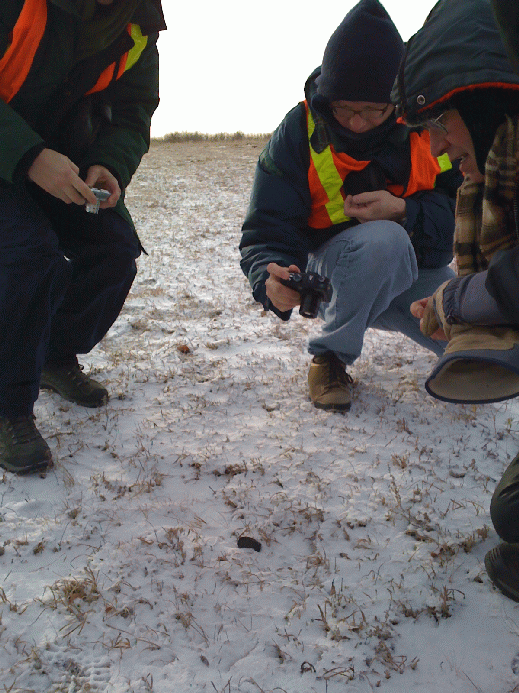
Here's one of my favorite images. Two nearly simultaneous Perseid meteors at 08:04:59 on August 8, 2007 UT from fireball3 (in Saskatoon):
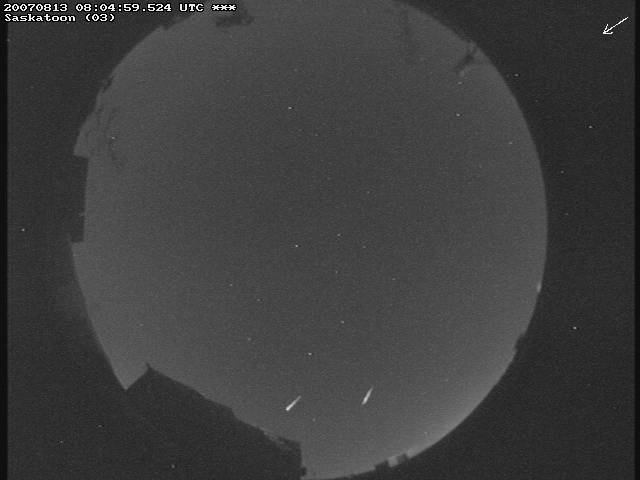
The northern lights are frequent in Saskatoon, but are not normally bright enough to trigger the fireball cameras. When they do the results are spectacular. Below are some northern light videos from fireball3 in Saskatoon:
March 8-9, 2008
|event-20080309-065424-03.m2v
|event-20080309-065614-03.m2v
|event-20080309-065630-03.m2v
|event-20080309-065632-03.m2v
|event-20080309-065650-03.m2v
|event-20080309-065653-03.m2v
|event-20080309-065657-03.m2v
|event-20080309-065701-03.m2v
|event-20080309-065710-03.m2v
|event-20080309-065721-03.m2v
|event-20080309-070007-03.m2v
|event-20080309-070012-03.m2v
|event-20080309-070037-03.m2v
|event-20080309-070131-03.m2v
|event-20080309-070134-03.m2v
|event-20080309-070159-03.m2v
|
Get the VLC plug-in if you cannot view these videos.
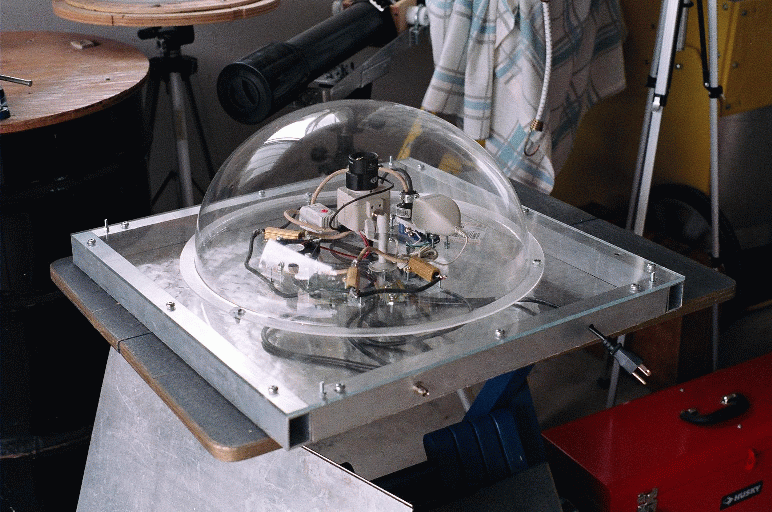
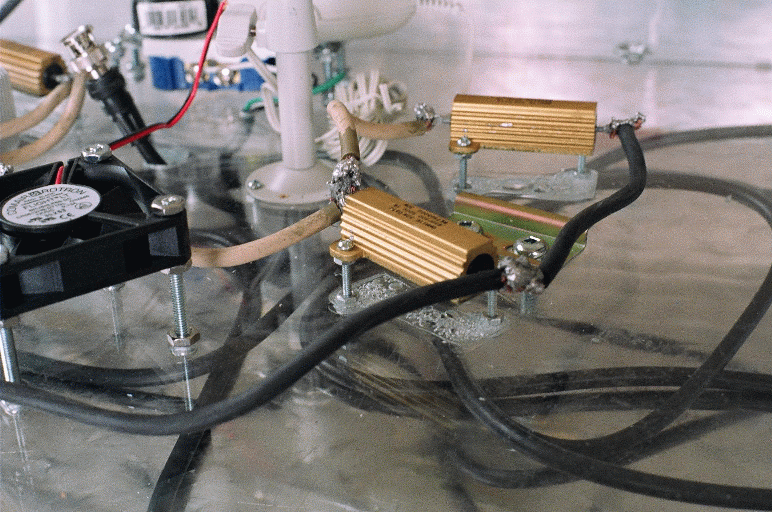
But the heat from the heating resistors melted the plexiglass!
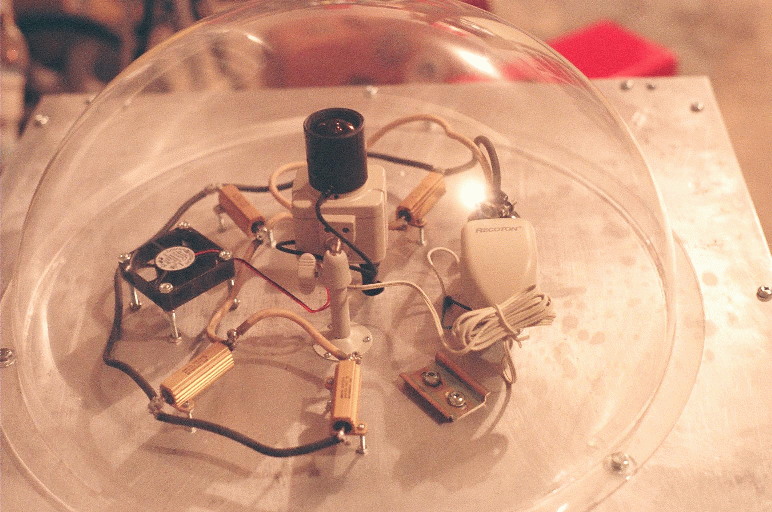
So the plexiglass has been replaced with aluminum. For those who are interested in building your own allsky cameras,
there are four 500 ohm resistors hooked up in parallel to 120V. So that's 28.8W x 4 = 115W. It's probably overkill, but I've never had any
snow, ice or condensation on the domes. Even after the wildest blizzard. There's a thermostat, behind the video camera in this view, that shuts off
the resistor heaters at about 15C. So, in Saskatchewan they are on most of the time.
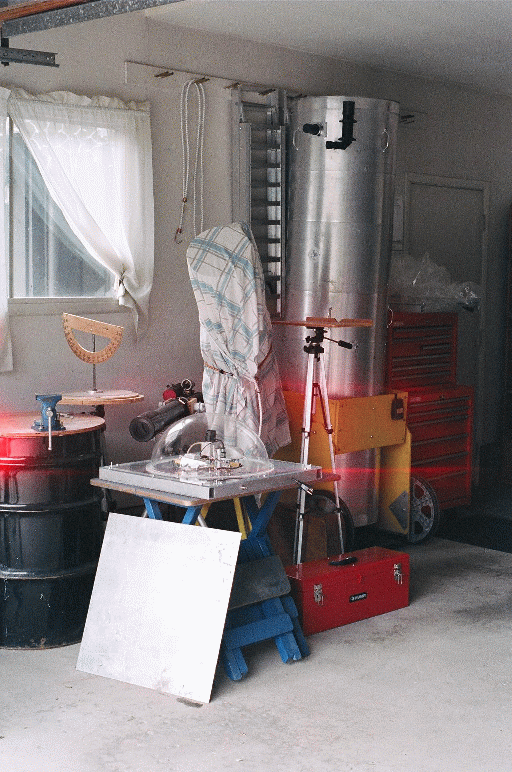
The meteor cameras where constructed in my garage and represent the continuation
of my telescope building projects that include an 8 inch f5 Newtonian (under
blanket), a 3 inch refractor (behind camera) and an 18 inch f5 Newtonian (biggest
object in picture). The second meteor camera may be seen on top of the tool cart. Also
visible is an inclinometer for visual fireball sightings and the barrel upon which the
8 and 18 inch mirrors were ground. [The plexglass base camera is awaiting its aluminum upgrade
here.]
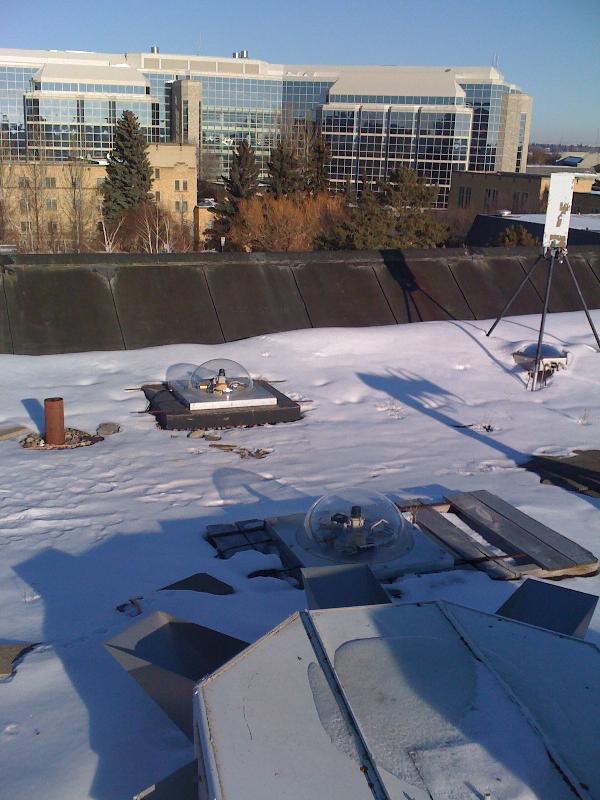
Here are fireball3 (foreground) and fireball4 (background) on the roof of the Physics building on the
University of Saskatchewan campus in Saskatoon. fireball4 has since been moved to near Lucky Lake,
Saskatchewan (see below).
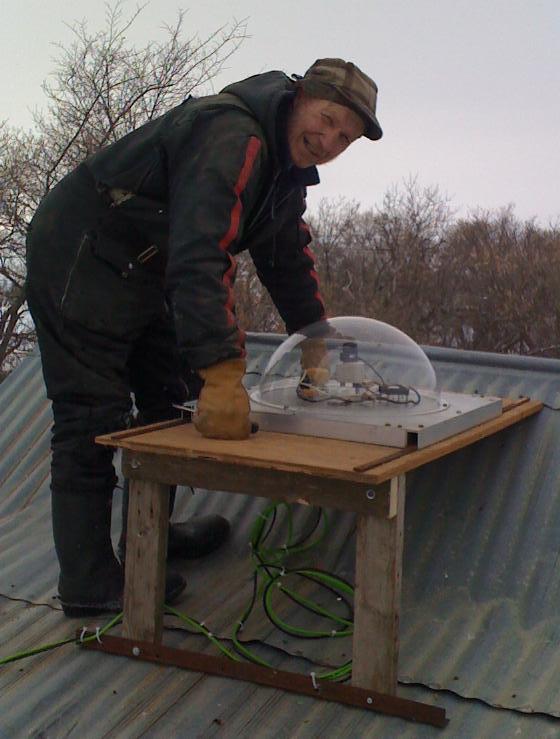
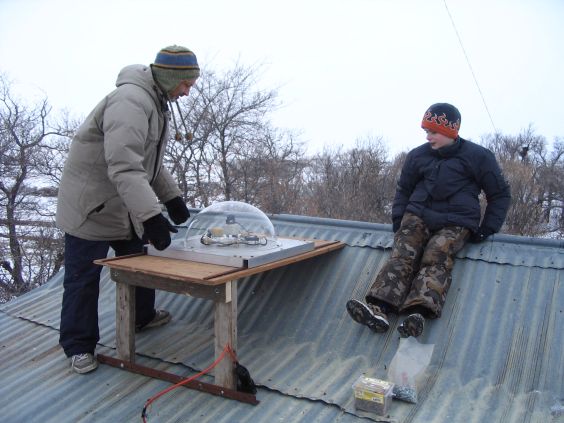
fireball4 was moved to Tenho Tuomi's place near Lucky Lake on February 16, 2009.
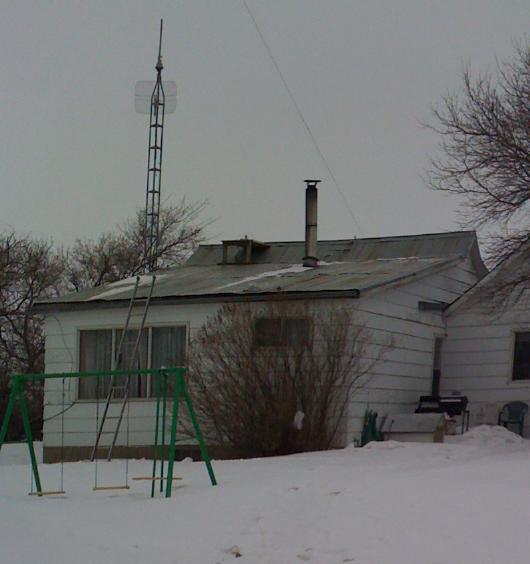
There it is on the roof of the house.

fireball4 joins the suite of weather and magnetometer equipment in Tenho's basement.
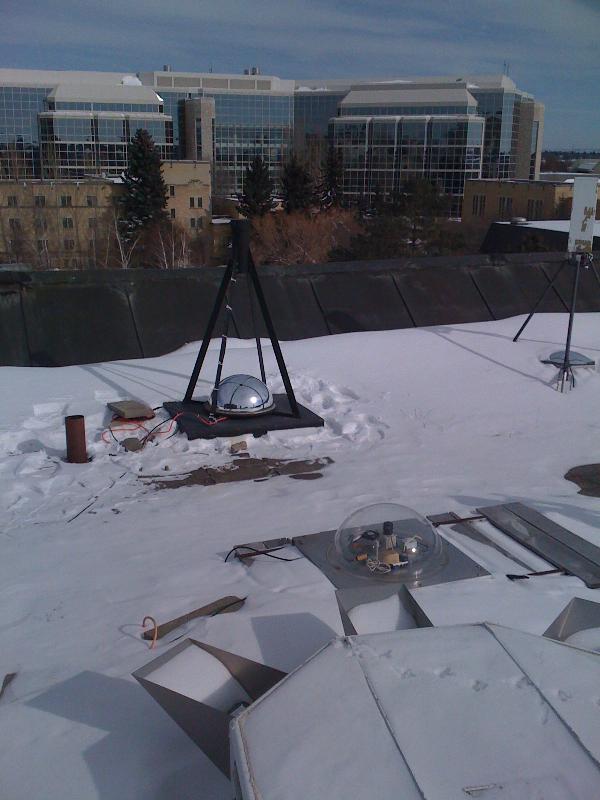
On February 22, 2009, fireball1, the refurbished old Sandia camera from Laird, took up fireball4's old
spot for a check out run.
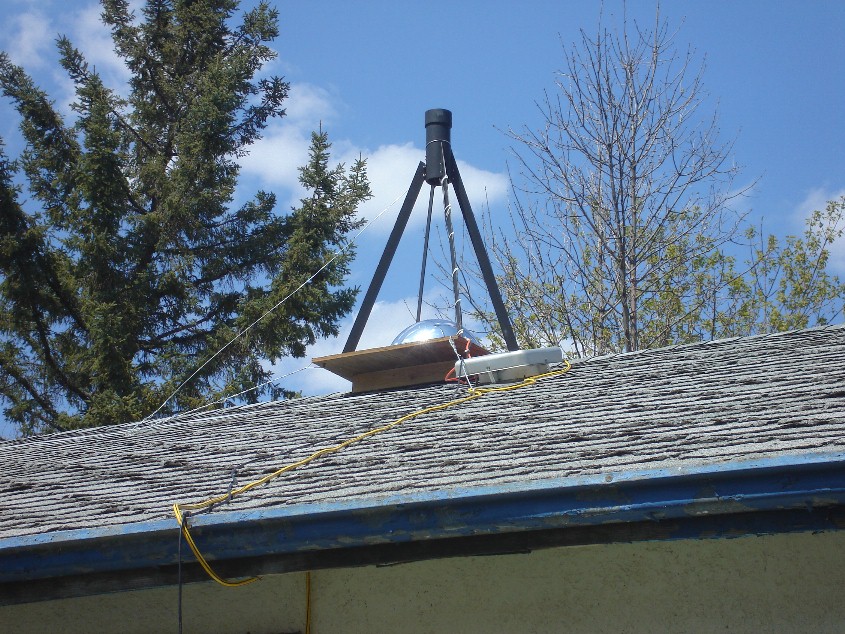
On May 12, 2009, Larry Gundrum, who I met searching for meteorites at Buzzard Coulee took fireball1 to Winnipeg.
Here is fireball1 on the roof of Larry's house. Larry has kept the camera running reliably ever since.
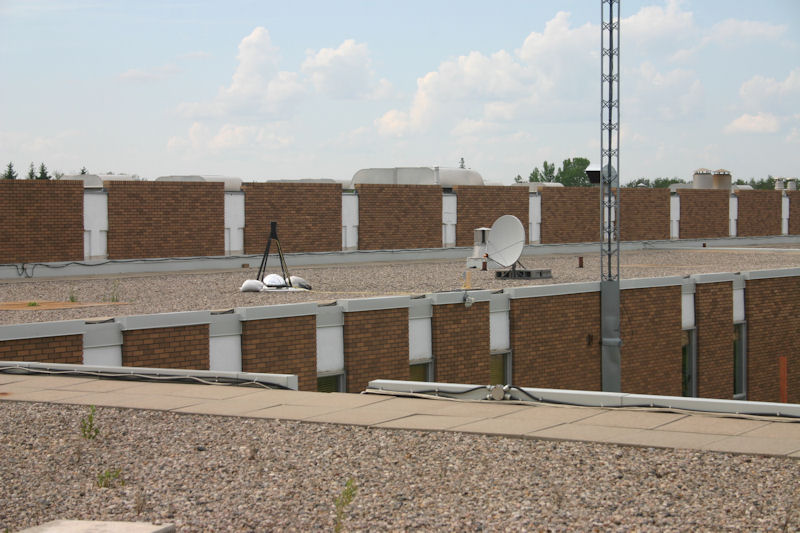
Here's fireball6, installed 2010 on a school roof in Yorkton. This location didn't work out because I couldn't communicate with the camera through the school's firewalled internet connection. Establishing an internet connection with the fireball cameras is the single most difficult problem to solve when installing a new camera.
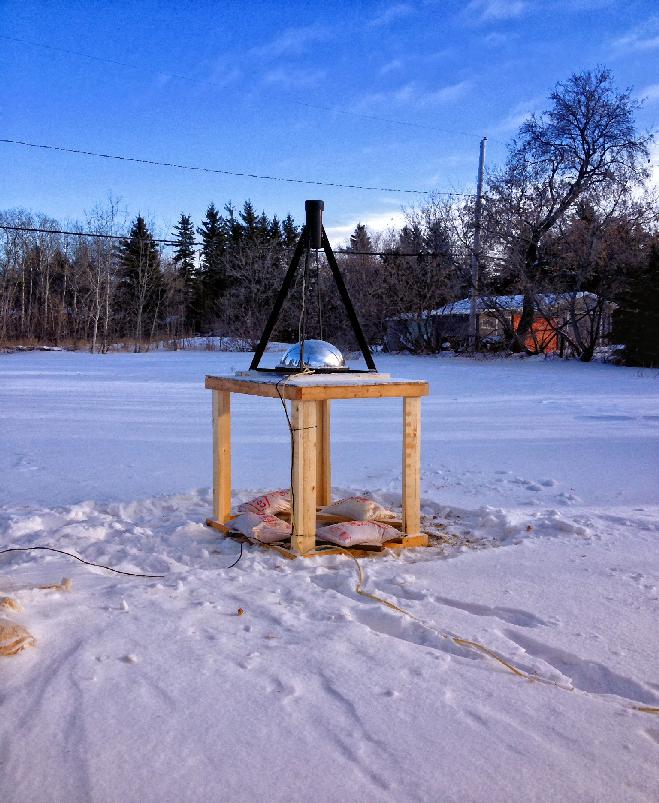
Here's fireball6 in late 2013, finally installed in a working location.

Here's fireball7, installed on Ron Lupack's roof in Dauphin. Ron took the camera offline in 2012 to pursue other projects.
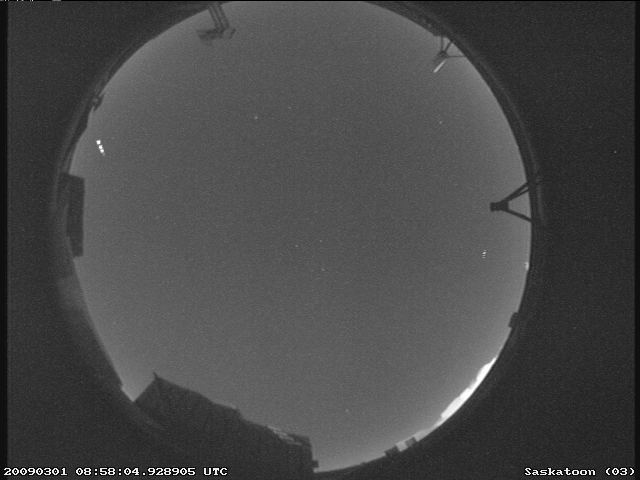
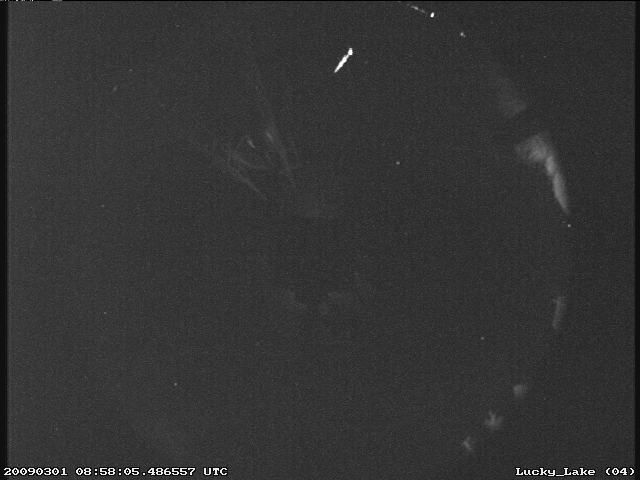
fireball3 and fireball4 both caught their first simultaneous meteor on March 1, 2009 as shown in the images above.
The data were automatically sent to a central computer named io which then computed an orbit shown below.
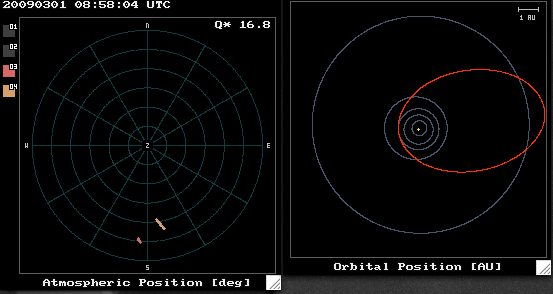
The central "correlator" computer io was replaced by luna in 2012 after io was broken into by hackers. I have taken steps to make the network computers are now more secure.
vidgrab (old version was metgrab) is a program Rob wrote that just records video to disk.
The --sdl means display it in a window and --dry means don't
actually write to disk.
When you want to restart the detection, run ~/scripts/startup.sh or (safer) reboot the machine: sudo reboot
For rejecting stationary events, the ~/meteor/etc/evproc.conf file needs to have a "reject spot" line added.
How to kill and restart asgard:
$ killall asgard
$ killall evctrl
$ killall dnotify
evctrl is used to start the daemon when the sun has sufficiently set and to stop it when it rises.
dnotify is a program that will run a script when something in a specified directory changes. Rob uses it on the older ubuntu installs to automatically run the asgard processor program on event files as they are detected. It has been superceded by something called inotify, and the evwait program uses this (but can't on the fireball3/4 systems) - it has the big advantage that it's very easy to reject events if there are multiple triggers in a row (above some set limit) - Rob has a workaround for the dnotify systems to do the same thing, but he's not sure if it's set up on fireball3/4.
Restart with ~/scripts/startup.sh (or reboot)
fireball2 is not used any more in favor of asgard, but it and the sentinel box are still around and functional.
The NASA Meteoroid Environment Office (MEO) is pleased to announce a new data product which meteor observers will find invaluable in determining which meteor showers are active based on real-time measurements. Using data gathered by the MEO-sponsored Canadian Meteor Orbit Radar, meteor activity in near real-time is now plotted on starcharts for observers to immediately gauge actual meteor activity from their location in Eastern North America. These maps show both the number of meteor radiants recorded by the radar and the speeds of meteoroids from each recorded radiant as measured by CMOR during the previous 24 hour period plotted on a starchart. These starcharts also identify known meteor showers which the radar has detected as being active during the previous day. The starcharts update every 15 minutes showing both what stars and meteor radiants are visible and can be viewed by clicking on the radar link at:
The sky chart plots are also augmented by Earth-centered plots - to toggle between these pages use the links at the top of the radar page. The Earth-centered plots show all meteor showers active throughout the day and their apparent strength from radar data.
The radar detects meteors in the magnitude +6 to +8 range - sub millimeter particle sizes.
Space Coast Intelligent Solutions (SCIS) links:
